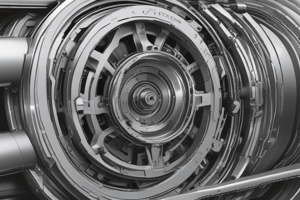Podcast
Questions and Answers
What is a characteristic of parts produced through drop forging?
What is a characteristic of parts produced through drop forging?
- They are brittle and prone to cracking.
- They are prone to wear and tear.
- They are lightweight and fragile.
- They are strong and durable. (correct)
What is the primary material worked with in wrought iron forging?
What is the primary material worked with in wrought iron forging?
- Cast iron
- Steel
- Wrought iron (correct)
- Aluminum
What is the purpose of a die in the metal bending process?
What is the purpose of a die in the metal bending process?
- To heat the metal to a malleable state
- To hold the metal in place while it is being bent (correct)
- To shape the metal into a specific form
- To cut the metal into a predetermined shape
Which of the following industries is NOT commonly associated with drop forging?
Which of the following industries is NOT commonly associated with drop forging?
What is the result of bending a metal workpiece using a punch and a die?
What is the result of bending a metal workpiece using a punch and a die?
Which of the following metal forming processes is NOT mentioned in the text?
Which of the following metal forming processes is NOT mentioned in the text?
What is the primary advantage of the rolling process?
What is the primary advantage of the rolling process?
Which metal forming process is ideal for producing complex shapes with intricate details?
Which metal forming process is ideal for producing complex shapes with intricate details?
What is the common characteristic of metals that can be used in the rolling process?
What is the common characteristic of metals that can be used in the rolling process?
What has played a significant role in predicting problems and shortening the time needed to optimize solutions in metal forming processes?
What has played a significant role in predicting problems and shortening the time needed to optimize solutions in metal forming processes?
What is the result of the liquid metal cooling and solidifying in the diecasting process?
What is the result of the liquid metal cooling and solidifying in the diecasting process?
What is the driving force behind the continuous research in metal forming processes?
What is the driving force behind the continuous research in metal forming processes?
Flashcards are hidden until you start studying
Study Notes
Metal Forming: Drop Forging, Wrought Iron Forging, Bending, Rolling, and Diecasting
Metal forming is a critical process in manufacturing that involves altering the form, surface, and material properties of a workpiece while preserving mass and cohesion. The processes of forming use various techniques such as drop forging, wrought iron forging, bending, rolling, and diecasting to shape metals into desired forms.
Drop Forging
Drop forging is a metal forming process that involves shaping metals using localized, compressive forces after heating the metal to a point where it's malleable. This process yields strong, durable parts that are resistant to wear and tear. Drop forging is commonly used in industries such as automotive, aerospace, and heavy machinery.
Wrought Iron Forging
Wrought iron forging is a metalworking process that involves shaping wrought iron, a type of iron that has been hot worked after smelting. This process can be done using various techniques, including hammering, rolling, and forging, to create a wide range of products, including tools, machinery parts, and architectural elements.
Bending
Metal bending is a metal forming process that involves bending a metal workpiece to a predetermined angle by pinching it between a punch and a die. This process is commonly used to bend metal sheets into V or U shapes for architectural, automotive, and other purposes.
Rolling
Rolling involves continually feeding a long strip of metal through drum rollers to attain the desired cross-section. This process is highly efficient and cost-effective, making it the preferred choice for producing long lengths of sheet metal with consistent profiles. Roll forming can handle various metals such as steel, aluminum, copper, and more.
Diecasting
Diecasting is a metal forming process that involves pouring liquid metal into a mold containing a hollow cavity of the desired shape. As the liquid cools and solidifies, it takes on the shape of the mold. This process is ideal for producing complex shapes and designs with intricate details that would be difficult or expensive to produce using other methods.
These metal forming processes are widely used in different industries, including automotive, aerospace, heavy machinery, and more. The evolution of these processes has been immense, with the use of software simulation playing a significant role in predicting problems and shortening the time needed to optimize solutions. The natural evolution of materials has led to the need for continuous research to achieve new features, including the identification and characterization of defects, exploration of new parameters for known processes, and the development of relatively recent processes such as single point incremental forming.
Studying That Suits You
Use AI to generate personalized quizzes and flashcards to suit your learning preferences.





